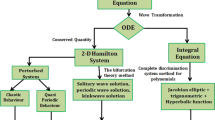Abstract
The periodic orbits and bifurcations in a class of second-order discontinuous systems with a hyperbolic boundary are studied in this paper. Specifically, a periodically forced discontinuous system described by three different linear subsystems is considered mainly to demonstrate the methodology. Analytical conditions for the reachability of local flows in each sub-domain and the passability of flows on the hyperbolic boundary are developed first. Then, through the return mapping structure of motions, the periodic orbits with or without sliding motions are analytically predicted, and the corresponding bifurcation analyses are carried out. Finally, numerical illustrations of periodic orbits are presented and the G-function is proposed to show the analytical criteria. The results obtained in this paper can be applied to the sliding mode control in discontinuous dynamical systems.









Similar content being viewed by others
References
Filippov AF (1988) Differential equations with discontinuous righthand side. Kluwer Academic, Netherlands
Kunze M, Küpper T, You J (1997) On the application of KAM theory to discontinuous dynamical systems. J Differ Equ 139(1):1–21
Cid JA, Sanchez L (2003) Periodic solutions for second order differential equations with discontinuous restoring forces. J Math Anal Appl 288(2):349–364
Jacquemard A, Teixeira MA (2012) Periodic solutions of a class of non-autonomous second order differential equations with discontinuous right-hand side. Physica D 241(22):2003–2009
Coll B, Gasull A, Prohens R (2001) Degenerate Hopf bifurcations in discontinuous planar systems. J Math Anal Appl 253(2):671–690
Küpper T, Moritz S (2001) Generalized Hopf bifurcation for non-smooth planar systems. Phil Trans R Soc Lond A 359:2483–2496
Zou Y, Küpper T, Beyn WJ (2006) Generalized Hopf bifurcation for planar Filippov systems continuous at the origin. J Nonlinear Sci 16:159–177
Akhmet MU (2005) Perturbations and Hopf bifurcation of the planar discontinuous dynamical system. Nonlinear Anal Theory 60(1):163–178
Han M, Zhang W (2010) On Hopf bifurcation in non-smooth planar system. J Differ Equ 248:2399–2416
Li L, Huang L (2014) Concurrent homoclinic bifurcation and Hopf bifurcation for a class of planar Filippov systems. J Math Anal Appl 411(1):83–94
Battelli F, Fečkan M (2012) Nonsmooth homoclinic orbits, Melnikov functions and chaos in discontinuous systems. Physica D 241:1962–1975
Leine RI, Van Campen DH, Van de Vrande BL (2000) Bifurcations in nonlinear discontinuous systems. Nonlinear Dyn 23(2):105–164
di Bernardo M, Kowalczyk P, Nordmark A (2002) Bifurcations of dynamical systems with sliding: derivation of normal-form mappings. Physica D 170(3–4):175–205
di Bernardo M, Kowalczyk P, Nordmark A (2003) Sliding bifurcations: a novel mechanism for the sudden onset of chaos in dry friction oscillators. Int J Bifur Chaos 13(10):2935–2948
Galvanetto U (2004) Sliding bifurcations in the dynamics of mechanical systems with dry friction-remarks for engineers and applied scientists. J Sound Vib 276(1–2):121–139
Kowalczyk P, di Bernardo M (2005) Two-parameter degenerate sliding bifurcations in Filippov systems. Physica D 204(3–4):204–229
Kowalczyk P, Piiroinen PT (2008) Two-parameter sliding bifurcations of periodic solutions in a dry-friction oscillator. Physica D 237(8):1053–1073
Guardia M, Hogan SJ, Seara TM (2010) An analytical approach to codimension2 sliding bifurcations in the dry-friction oscillator. SIAM J Appl Dyn Syst 9(3):769C798
Luo ACJ (2005) A theory for non-smooth dynamical systems on connectable domains. Commun Nonlinear Sci Numer Simul 10:1–55
Luo ACJ (2005) Imaginary, sink and source flows in the vicinity of the separatrix of non-smooth dynamic system. J Sound Vib 285:443–456
Luo ACJ (2006) Singularity and dynamics on discontinuous vector fields. Elsevier, Amsterdam
Luo ACJ (2011) On flow barriers and switchability in discontinuous dynamical systems. Int J Bifur Chaos 21(1):1–76
Luo ACJ (2005) The mapping dynamics of periodic motions for a three-piecewise linear system under a periodic excitation. J Sound Vib 283:723–748
Luo ACJ, Rapp BM (2009) Flow switchability and periodic motions in a periodically forced, discontinuous dynamical system. Nonlinear Anal Real 10(5):3028–3044
Luo ACJ, Rapp BM (2010) On motions and switchability in a periodically forced, discontinuous system with a parabolic boundary. Nonlinear Anal Real 11(14):2624–2633
Luo ACJ, Gegg BC (2006) Periodic motions in a periodically forced oscillator moving on an oscillating belt with dry friction. ASME J Comput Nonlinear Dyn 1:132–168
Luo ACJ, Gegg BC (2006) Dynamics of a periodically forced oscillator with dry friction on a sinusoidally time-varying traveling surface. Int J Bifur Chaos 16:3539–3566
Gegg BC, Luo ACJ, Suh SC (2009) Sliding motions on a periodically time-varying boundary for a friction-induced oscillator. J Vib Control 15(5):671–703
Luo ACJ, Huang J (2012) Discontinuous dynamics of a non-linear, self-excited, friction-induced, periodically forced oscillator. Nonlinear Anal Real 13(1):241–257
Zhang ZF, Ding TR, Huang WZ, Dong ZX (1992) Qualitative theory of differential equations, vol 101. American Mathematical Society, Providence, RI
Author information
Authors and Affiliations
Corresponding author
Additional information
Research supported by National Natural Science Foundation of China (61473332) and Zhejiang Provincial Natural Science Foundation (LQ14A010009).
Appendix
Appendix
Consider second order differential equation in Eq. (2) with initial condition \((x_0, \dot{x}_0, t_0)\in R^3\), whose solution \((x^{(i)}(t; x_0, \dot{x}_0, t_0), \dot{x}^{(i)}(t; x_0, \dot{x}_0, t_0))\) (for simplicity, denote by \((x^{(i)}(t), \dot{x}^{(i)}(t))\)) in corresponding domains \(\Omega _i\) (\(i\in \{1, 2, 3\}\)) is given as follows.
Case 1 \(d_i^2>c_i\).
where \(\lambda _{1,2}^{(i)}=-d_i\pm \sqrt{d_i^2-c_i},\,\,\omega _d^{(i)}=\sqrt{d_i^2-c_i}\), and
Case 2 \(d_i^2<c_i\).
where \(\omega _d^{(i)}=\sqrt{c_i-d_i^2}\), constants \(A^{(i)},\,\,B^{(i)}\) and \(C^{(i)}\) are the same as case 1), and
Case 3 \(d_i^2=c_i\).
where \(\lambda _1^{(i)}=-2d_i\), constants \(A^{(i)},\,\,B^{(i)}\) and \(C^{(i)}\) are the same as case 1), and
Rights and permissions
About this article
Cite this article
Li, L., Luo, A.C.J. Periodic orbits and bifurcations in discontinuous systems with a hyperbolic boundary. Int. J. Dynam. Control 5, 513–529 (2017). https://doi.org/10.1007/s40435-016-0246-x
Received:
Revised:
Accepted:
Published:
Issue Date:
DOI: https://doi.org/10.1007/s40435-016-0246-x




